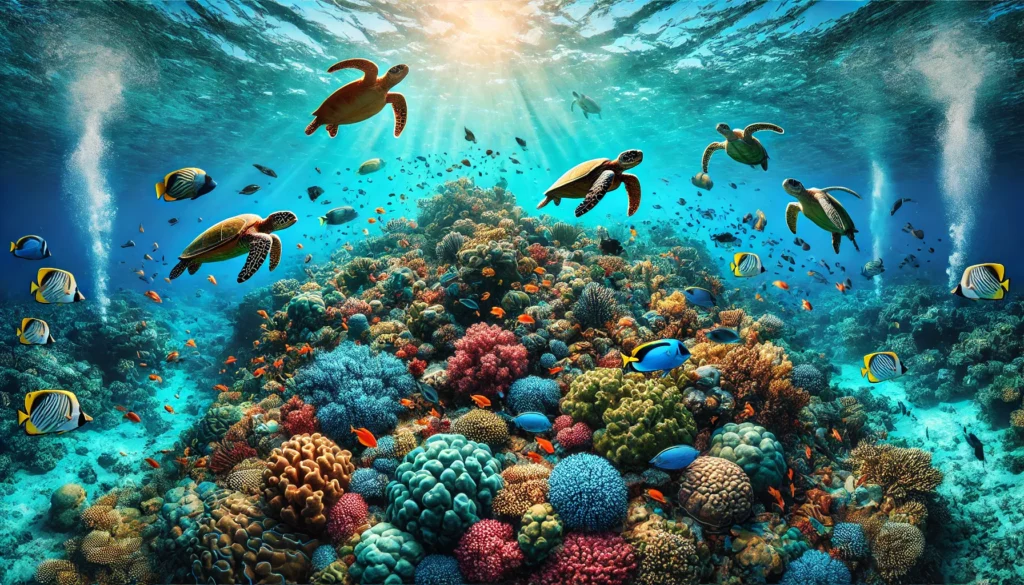Ahoy, fellow ocean enthusiasts and landlubbers alike! Grab your snorkels and fins, because we’re about to take a deep dive into one of the most spectacular underwater wonderlands on Earth. Nestled in the heart of the Coral Triangle, Tubbataha Reef National Park is the crown jewel of Philippine marine biodiversity. This UNESCO World Heritage Site is not just a pretty face (or should I say, a pretty coral formation?) – it’s a shining example of how effective marine conservation can turn the tide on environmental degradation.
Picture this: crystal-clear waters stretching as far as the eye can see, vibrant coral reefs teeming with life, and more fish species than you can shake a diving rod at. Tubbataha is like the all-you-can-eat buffet of the ocean world, except here, we’re feasting our eyes, not our bellies. But before we dive headfirst into the wonders of Tubbataha, let’s set the stage for our underwater adventure and explore why this remote paradise is making waves in the world of marine conservation.
A Brief History: From Hidden Gem to Global Sensation
The Discovery of an Underwater Treasure
Once upon a time, in a galaxy not so far away (okay, it was just in the Sulu Sea), Tubbataha Reef was the ocean’s best-kept secret. For centuries, only local fishermen knew about this underwater Eden, using it as a pit stop during their fishing expeditions. Little did they know they were sitting on a goldmine of biodiversity – or should we say, a coral mine?
It wasn’t until the 1970s that the rest of the world caught wind of Tubbataha’s existence. Picture a bunch of scuba divers stumbling upon this underwater paradise and probably thinking they’d found Atlantis. Their discovery set off a chain reaction that would eventually lead to Tubbataha becoming the poster child for marine conservation in the Philippines and beyond.
From Fishing Ground to Protected Area
Now, you might think that once word got out about Tubbataha, it would’ve been smooth sailing (pun intended) towards conservation. But hold your seahorses! The journey from fishing ground to protected area was more like a roller coaster ride on choppy waters. In the 1980s, Tubbataha faced a storm of threats, from dynamite fishing to coral harvesting. It was like watching a nature documentary gone wrong – cue the dramatic music and concerned narrator voice.
But fear not, for our story has a happy ending! In 1988, then-President Corazon Aquino declared Tubbataha Reef a National Marine Park, effectively giving it a big, legislative hug of protection. This was followed by its designation as a UNESCO World Heritage Site in 1993, cementing its status as a marine superstar. Talk about a glow-up!
The Marvels of Tubbataha: A Biodiversity Hotspot
A Coral Reef Extravaganza
Alright, nature nerds, prepare to have your minds blown by the sheer awesomeness that is Tubbataha’s biodiversity. This place is like the New York City of the underwater world – bustling, diverse, and never sleeping (well, except for those lazy nurse sharks). Tubbataha boasts an impressive array of marine life that would make even the most seasoned marine biologist weak in the flippers.
Let’s break down this underwater metropolis by the numbers:
| Feature | Statistics |
|---|---|
| Total Area | 97,030 hectares |
| Coral Species | Over 360 |
| Fish Species | More than 600 |
| Bird Species | 11 (on islets) |
| Sea Turtle Species | 2 |
| Whale and Dolphin Species | At least 13 |
These aren’t just numbers, folks. We’re talking about a coral reef system that’s home to nearly half of all known coral species in the world. It’s like Mother Nature decided to show off and create an underwater version of Noah’s Ark, minus the whole flood thing (because, you know, they’re already underwater).
The Cast of Characters
Now, let’s meet some of the star players in this underwater circus. First up, we have the coral reefs themselves – the unsung heroes of the ocean. These living structures come in all shapes and sizes, from branching staghorns to massive brain corals. They’re like the apartment buildings of the sea, providing homes for countless marine critters.
Swimming through these coral neighborhoods, you’ll find a cast of characters that would put any Hollywood blockbuster to shame. There’s the clownfish, made famous by a certain animated film (no, we won’t name it – we don’t want to get sued). These little orange jokers dart in and out of sea anemones like they’re playing a game of underwater hide-and-seek.
Then we have the groupers, the gentle giants of the reef. These big, grumpy-looking fish are like the bouncers of the underwater world, keeping an eye on things and making sure everyone behaves. And let’s not forget about the sea turtles, gracefully gliding through the water like they’re in slow motion. They’re the zen masters of the ocean, always looking chill despite the chaos around them.
But wait, there’s more! Tubbataha is also a pit stop for some of the ocean’s most magnificent creatures. Whale sharks, those gentle behemoths of the sea, occasionally cruise through these waters, probably on their way to some exclusive underwater party. And if you’re lucky, you might spot a pod of dolphins playing in the waves, showing off their acrobatic skills like they’re auditioning for Sea World (but don’t worry, they’re much happier here in the wild).
The Conservation Success Story: Turning the Tide
A Recipe for Marine Protection
Now, you might be wondering: “How did Tubbataha manage to stay so pristine when other reefs are struggling?” Well, my curious friend, it’s all thanks to a winning combination of smart management, strict enforcement, and a dash of good old-fashioned community involvement. It’s like baking a cake, except instead of flour and sugar, we’re using science and law enforcement (and trust me, it tastes much better than it sounds).
Let’s break down this conservation cake recipe:
- Ingredient #1: No-Take Zone Policy – Imagine a giant “Do Not Touch” sign plastered across the entire park. That’s basically what a no-take zone is. It means no fishing, no collecting, no nothing (except for approved research and monitoring activities). It’s like putting the entire reef in a giant bubble of protection.
- Ingredient #2: Year-Round Ranger Station – Picture a group of dedicated rangers living on a tiny islet in the middle of nowhere, braving storms and isolation to protect the reef. These real-life ocean superheroes patrol the waters, making sure no one’s trying to sneak in a fishing line or drop an anchor where they shouldn’t.
- Ingredient #3: Strict Visitor Regulations – Tubbataha isn’t your average tourist destination. You can’t just show up with your inflatable flamingo float and expect to splash around. Visitor numbers are limited, and dive boats need special permits. It’s like getting into an exclusive underwater club, but instead of a bouncer, you’ve got park rangers checking your credentials.
- Ingredient #4: Community Involvement – The local communities, especially in Cagayancillo (the nearest inhabited island), are actively involved in conservation efforts. It’s like having a neighborhood watch program, but for an entire ecosystem.
- Ingredient #5: Science-Based Management – Regular monitoring and research inform management decisions. It’s like having a team of underwater detectives constantly solving the mystery of “How’s the reef doing today?”
Mix all these ingredients together, and voilà! You’ve got yourself a recipe for marine conservation success.
The Proof is in the Coral Pudding
Now, I know what you’re thinking: “That all sounds great on paper, but does it actually work?” Well, hold onto your diving masks, because the results are in, and they’re more impressive than a shark doing a backflip (which, admittedly, I’ve never seen, but I imagine it would be pretty cool).
Let’s look at some before-and-after snapshots:
| Aspect | Before Protection | After Protection (as of 2020) |
|---|---|---|
| Live Coral Cover | ~30% (1980s) | ~50% |
| Fish Biomass | Declining | Increased by over 200% |
| Illegal Fishing Incidents | Common | Rare |
| Tourist Numbers | Unregulated | Controlled (max 14,000/year) |
These numbers aren’t just impressive; they’re downright jaw-dropping (careful not to drop your regulator, though). Tubbataha has managed to swim against the current of global coral reef decline, proving that with the right approach, we can turn the tide on marine ecosystem degradation.
Lessons from the Reef: What Can We Learn?
The Tubbataha Template
Alright, class, it’s time to take notes because Tubbataha is about to school us on marine conservation. This reef isn’t just a pretty face; it’s a living, breathing (well, kind of) case study in how to protect our oceans. So, what pearls of wisdom can we pluck from this underwater oyster?
1. Isolation Can Be a Good Thing
Tubbataha’s remote location, while a pain for those of us with a fear of long boat rides, is actually one of its greatest assets. It’s like nature’s version of “social distancing” – keeping the reef far from the madding crowd and the pressures of coastal development. The lesson? Sometimes, the best thing we can do for an ecosystem is to leave it alone.
2. Strict Protection Pays Off
The no-take policy might seem harsh, especially to fishermen used to casting their nets wherever they please. But it’s this tough love approach that has allowed Tubbataha to flourish. It’s like putting the entire reef on a strict diet and exercise regimen – a little painful at first, but the long-term benefits are worth it.
3. Community Buy-In is Crucial
Involving local communities in conservation efforts isn’t just a nice PR move; it’s essential for long-term success. The people of Cagayancillo have become the reef’s biggest cheerleaders, proving that when people understand the value of conservation, they’ll fight to protect it. It’s like turning the entire community into a team of underwater superheroes.
4. Science Should Guide Management
Regular monitoring and research aren’t just for the nerds in lab coats (no offense to the nerds in lab coats – you’re doing great work!). This data-driven approach ensures that management decisions are based on facts, not feelings. It’s like having a crystal ball that tells you exactly what the reef needs.
5. Sustainable Tourism Can Work
Tubbataha proves that you can have your cake and eat it too – or in this case, protect your reef and let people enjoy it too. By strictly regulating visitor numbers and activities, the park manages to balance conservation with tourism revenue. It’s like running an exclusive underwater club where the VIPs are the fish.
Challenges and Future Prospects: Navigating Rough Waters
The Stormy Seas Ahead
Now, before we get too carried away patting ourselves on the back (careful not to knock over your scuba tank), it’s important to remember that Tubbataha, like all reefs, faces some serious challenges. Climate change, that pesky party pooper, is knocking at the door, and it’s not bringing a nice bottle of wine.
Rising Temperatures: The Unwelcome Hot Tub
Global warming is turning our oceans into a giant hot tub, and not the fun kind. Rising sea temperatures can lead to coral bleaching, which is about as pleasant for corals as a sunburn is for us. Tubbataha has been relatively lucky so far, but it’s not immune to this global threat.
Ocean Acidification: The Sour Note
As if warming wasn’t enough, our oceans are also becoming more acidic thanks to increased CO2 absorption. It’s like someone’s slowly turning the entire ocean into a giant bowl of lemonade, which might sound refreshing but is actually terrible for marine life.
Plastic Pollution: The Unwanted Flotsam
Even in its remote location, Tubbataha isn’t safe from the scourge of plastic pollution. Currents can carry trash from far and wide, turning parts of the ocean into an underwater garbage dump. It’s like the world’s worst mail delivery service, bringing plastic to even the most pristine corners of the sea.
The Road Ahead: Charting a Course for the Future
Despite these challenges, the future of Tubbataha looks brighter than a bioluminescent squid (which, by the way, are really cool – look them up!). The success of its conservation model has made it a beacon of hope in the world of marine protection. Here’s what’s on the horizon:
Expanding the Model
The Tubbataha approach is being studied and adapted for other marine protected areas in the Philippines and beyond. It’s like the reef is giving free lessons in “How to Save an Ecosystem 101.”
Strengthening Resilience
Efforts are underway to enhance the reef’s resilience to climate change. This includes everything from reducing local stressors to exploring innovative conservation techniques. It’s like giving the reef a suit of armor to face the battles ahead.
Enhancing Education and Awareness
Tubbataha is becoming an increasingly important site for marine research and education. By sharing its story and lessons, it’s inspiring a new generation of ocean advocates. It’s like the reef is running its own TED Talk, but underwater and with better visuals.
A Reef of Hope
As we surface from our deep dive into Tubbataha Reef National Park, we’re left with more than just stunning mental images of colorful corals and fish (and maybe a touch of imaginary decompression sickness). We’re left with hope. Hope that with the right mix of protection, management, and community involvement, we can turn the tide on marine ecosystem degradation.
Tubbataha stands as a testament to what’s possible when we decide to take conservation seriously. It’s a reminder that our oceans, given a chance, have an incredible capacity for resilience and recovery. So the next time you hear someone say that saving our oceans is a lost cause, just point them to this remote reef in the Sulu Sea. It’s proof that with a little effort (okay, a lot of effort) and some smart thinking, we can create underwater paradises that thrive.
As we bid farewell to Tubbataha (at least until our next diving trip), let’s carry its lessons with us. Whether we’re planting coral, picking up beach trash, or just being more mindful of our plastic use, we can all play a part in protecting our blue planet. After all, in the wise words of a certain singing crab, “Darling it’s better, down where it’s wetter, under the sea!” (Oops, I hope Disney doesn’t sue me for that one).
So here’s to Tubbataha, the little reef that could, and to all the marine protected areas following in its wake. May your corals stay colorful, your fish stay plentiful, and your waters stay crystal clear. And remember, folks: keep calm and coral on!
Disclaimer: This blog post is based on information available up to 2020. While we’ve done our best to ensure accuracy, the marine world is as changeable as the tides. If you spot any inaccuracies or have updated information, please let us know so we can correct them faster than a parrotfish can change colors. Remember, in the world of marine conservation, staying current is key – unlike that old wetsuit in your closet that you swear you’ll fit into again someday.




